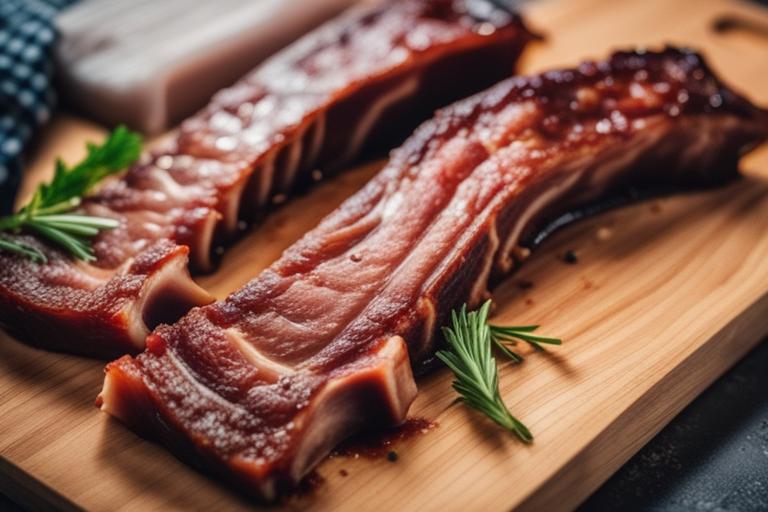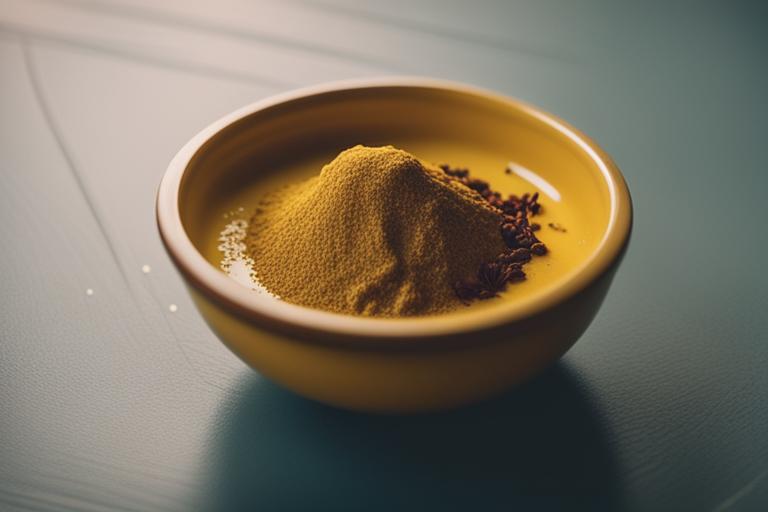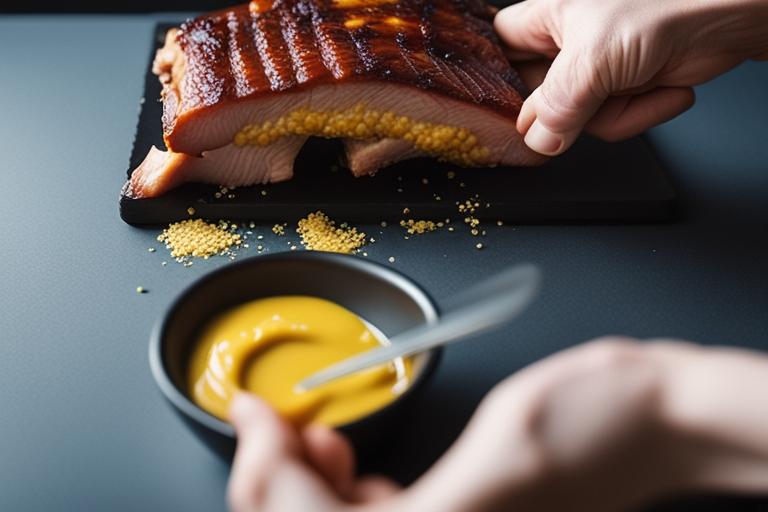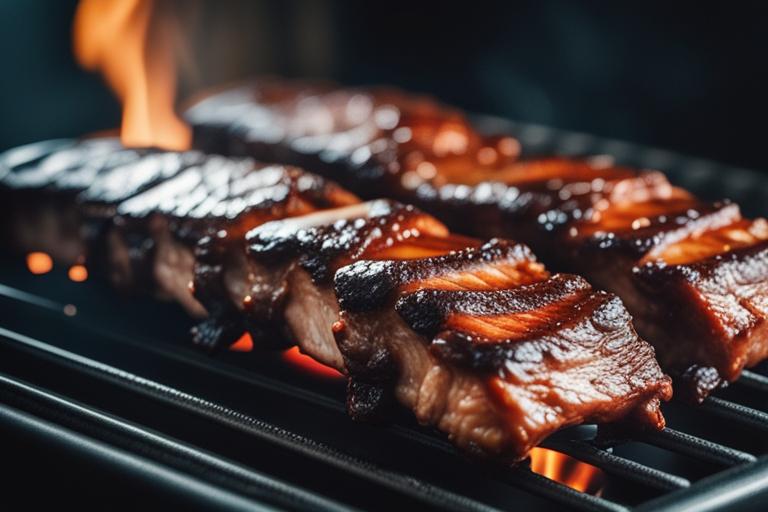Are you looking for a new way to elevate your barbecue game? Look no further than using mustard as a rub for your ribs. In this guide, we’ll explore the science behind using mustard on ribs, how to prepare and apply the rub, and tips for cooking and serving delicious, mouth-watering ribs.
Mustard on Ribs: Your Ultimate Guide
Learn how to use mustard as a rub for ribs with this comprehensive guide.
– Understand the science behind using mustard to tenderize and enhance flavor.
– Learn how to prepare your ribs, make the mustard rub, and apply it properly.
– Discover various cooking methods, serving suggestions, and storage tips.

The Science behind Using Mustard on Ribs
Mustard is a popular ingredient in barbecue rubs because the acidity in mustard helps to tenderize the meat and enhance its flavor. Additionally, mustard serves as a binder, helping to hold other spices in place and ensuring an even coating on the meat. When it comes to ribs, the combination of mustard and smoke creates a delicious flavor profile. The smokiness of the ribs complements the tanginess of the mustard, resulting in a savory, irresistible taste.

Preparing Ribs for the Mustard Rub
Before applying the mustard rub, it’s important to prepare the ribs properly to ensure optimal flavor. There are three main types of ribs: baby back, spare, and St. Louis. Baby back ribs are the most tender and lean, while spare ribs are meatier and have more fat. St. Louis-style ribs are a trimmed-down version of spare ribs, with the rib tips removed.
To prepare the ribs, remove the membrane from the back of the ribs by sliding a butter knife under the membrane and pulling it off in one piece. Trim any excess fat from the ribs, leaving a thin layer for flavor and moisture. Finally, pre-season the meat with salt, pepper, and any other desired spices to enhance the flavor of the final product.

Making the Mustard Rub
The mustard rub is the key to flavorful and tender ribs. Here’s a simple recipe to get you started:
- 1/2 cup yellow mustard
- 1/4 cup brown sugar
- 1 tablespoon paprika
- 1 tablespoon garlic powder
- 1 tablespoon onion powder
- 1 tablespoon chili powder
- 1 teaspoon cumin
- 1 teaspoon salt
- 1/2 teaspoon black pepper
Mix all ingredients together in a bowl until well combined. This recipe makes enough rub for a rack of ribs, but can be adjusted based on the amount of meat you’re cooking. For extra flavor, feel free to add additional spices such as cayenne pepper, oregano, or thyme.

Applying the Mustard Rub
When applying the mustard rub, it’s important to use the right techniques to ensure maximum flavor. Start by generously coating the ribs with the mustard rub, using your hands to massage it into the meat. Be sure to cover all areas of the meat evenly, including the ends and edges. You can also use a brush to apply the mustard rub evenly and avoid clumping. Once the rub is applied, cover the ribs with plastic wrap and refrigerate for at least 30 minutes to allow the flavors to penetrate the meat.

Cooking the Ribs with Mustard Rub
Now it’s time to cook the ribs with the mustard rub. There are several methods you can use, including smoking, grilling, and oven techniques. The key is to cook the meat low and slow to allow the flavors to develop and the meat to become tender.
For smoking, preheat your smoker to 225°F and place the ribs on the grate, bone side down. Smoke the ribs for 3-4 hours, or until the internal temperature reaches 165°F. For grilling, preheat your grill to medium heat and place the ribs on the grate, bone side down. Grill the ribs for 1-2 hours, or until the internal temperature reaches 165°F. For oven cooking, preheat your oven to 275°F and place the ribs on a baking sheet. Cook the ribs for 3-4 hours, or until the internal temperature reaches 165°F.
When cooking the ribs, be sure to check for doneness and avoid overcooking. The meat should be tender and juicy, with a slight pull from the bone. For extra flavor, you can baste the ribs with barbecue sauce during the final 30 minutes of cooking.
Serving Mustard on Ribs
Finally, it’s time to serve your delicious mustard on ribs. Pair the ribs with your favorite side dishes, such as coleslaw, baked beans, or corn on the cob. For a tangy twist, serve with a side of mustard-based barbecue sauce.
When it comes to presentation, you can add a garnish of fresh herbs or sliced onions for a pop of color. To store leftover ribs, wrap tightly in foil or plastic wrap and refrigerate for up to 3 days. To reheat, wrap the ribs in foil and heat in a 350°F oven for 15-20 minutes, or until heated through.
Pros and Cons of Using Mustard on Ribs
| Pros | Cons |
|---|---|
| Tenderizes the meat | May not be suitable for those with mustard allergies |
| Enhances flavor | Mustard flavor may not be suitable for all taste preferences |
| Serves as a binder for other spices | Mustard rub may not adhere well to the meat without proper application |
| Creates a delicious flavor profile when combined with smoke | May require additional time for preparation and refrigeration |
|Question | Answer |
| — | — |
| What type of ribs are best for using mustard as a rub? | All types of ribs can benefit from using mustard as a rub, but baby back ribs are the most tender and lean, making them a great choice for this technique. |
| How long should I refrigerate the ribs after applying the mustard rub? | It’s best to refrigerate the ribs for at least 30 minutes to allow the flavors to penetrate the meat. You can refrigerate the ribs for up to 24 hours for even more flavor. |
| Can I use a different type of mustard for the rub? | Yes, you can use any type of mustard for the rub, but yellow mustard is the most commonly used. |
| Alternatives for those with mustard allergies or taste preferences that do not favor mustard flavor | For those with mustard allergies, you can try using a vinegar-based rub or a rub using apple juice. You can also try using a rub that substitutes mustard with mayonnaise or honey. For those who do not favor the taste of mustard, you can try reducing the amount of mustard in the recipe or using a different type of mustard, such as dijon or honey mustard.|
FAQs
What type of ribs are best for using mustard as a rub?
All types of ribs can benefit from using mustard as a rub, but baby back ribs are the most tender and lean, making them a great choice for this technique.
How long should I refrigerate the ribs after applying the mustard rub?
It’s best to refrigerate the ribs for at least 30 minutes to allow the flavors to penetrate the meat. You can refrigerate the ribs for up to 24 hours for even more flavor.
Can I use a different type of mustard for the rub?
Yes, you can use any type of mustard for the rub, but yellow mustard is the most commonly used.
Alternatives for those with mustard allergies or taste preferences that do not favor mustard flavor
For those with mustard allergies, you can try using a vinegar-based rub or a rub using apple juice. You can also try using a rub that substitutes mustard with mayonnaise or honey. For those who do not favor the taste of mustard, you can try reducing the amount of mustard in the recipe or using a different type of mustard, such as dijon or honey mustard.
Insider Tip: “For an extra kick of flavor, try adding a tablespoon of apple cider vinegar to the mustard rub recipe.”
Nutritional Value
Mustard is a low-calorie and low-fat ingredient that adds flavor and nutrition to your ribs. It is high in antioxidants and contains vitamins A and C, calcium, iron, and magnesium. Brown sugar is a source of carbohydrates and adds sweetness to the rub. Paprika is loaded with vitamin A and has anti-inflammatory properties. Garlic and onion powder are rich in antioxidants, while chili powder is a good source of vitamin C. Cumin is a good source of iron and helps with digestion. Salt and black pepper add flavor to the rub but should be used in moderation.
Conclusion
Using mustard as a rub for ribs is a delicious and easy way to elevate your barbecue game. With the science behind it, tips on preparation and application, cooking methods, serving suggestions, alternatives for those with mustard allergies or taste preferences, and nutritional value, you’ll be a rib master in no time. Experiment with different variations of the mustard rub to find your perfect flavor profile and enjoy the mouth-watering results.
Personal Story: My First Time Using Mustard on Ribs
When I first heard about using mustard as a rub for ribs, I was skeptical. I had always used a dry rub or marinade, and the idea of using a condiment seemed strange. However, after hearing rave reviews from a friend, I decided to give it a try.
I followed the recipe for the mustard rub, adding a few extra spices to customize it to my taste. As I applied the rub to the ribs, I could smell the tangy mustard and other spices coming together to create a mouth-watering aroma.
When it was time to cook the ribs, I opted for smoking them to get that classic BBQ flavor. As I watched them slowly cook, the mustard and spices created a dark, crispy bark on the outside. I couldn’t wait to try them.
When I took my first bite, I was blown away. The mustard had tenderized the meat, making it juicy and flavorful. The spices had infused into the meat, creating a delicious balance of sweet and savory. I couldn’t believe I had waited so long to try using mustard on ribs.
Since then, I’ve experimented with different variations of the mustard rub, trying out different types of mustard and spices. Each time, I’m amazed at how much flavor it adds to the ribs. Using mustard as a rub has become a staple in my BBQ repertoire, and I can’t wait to share this delicious technique with others.
Follow us!!